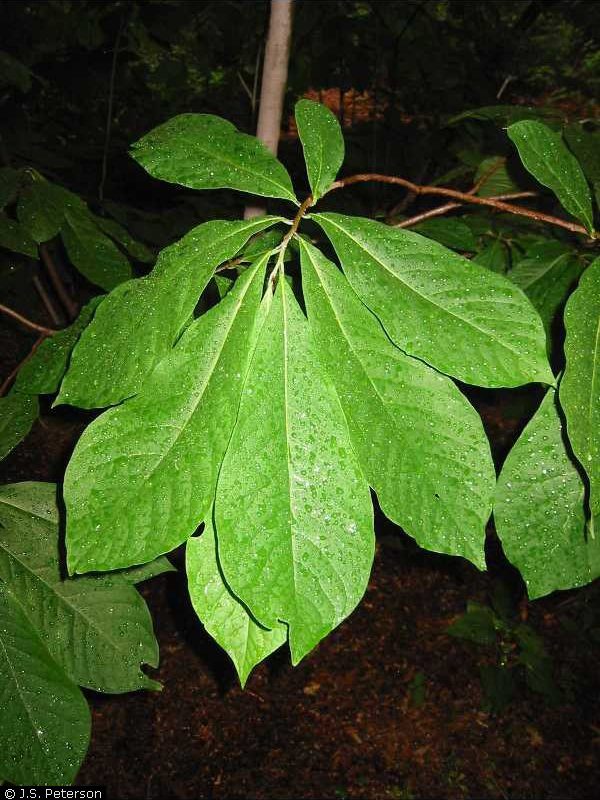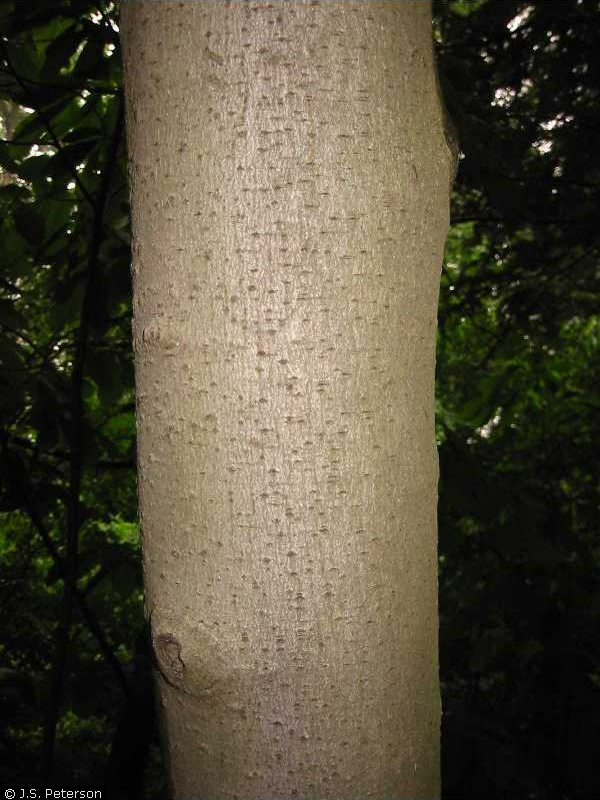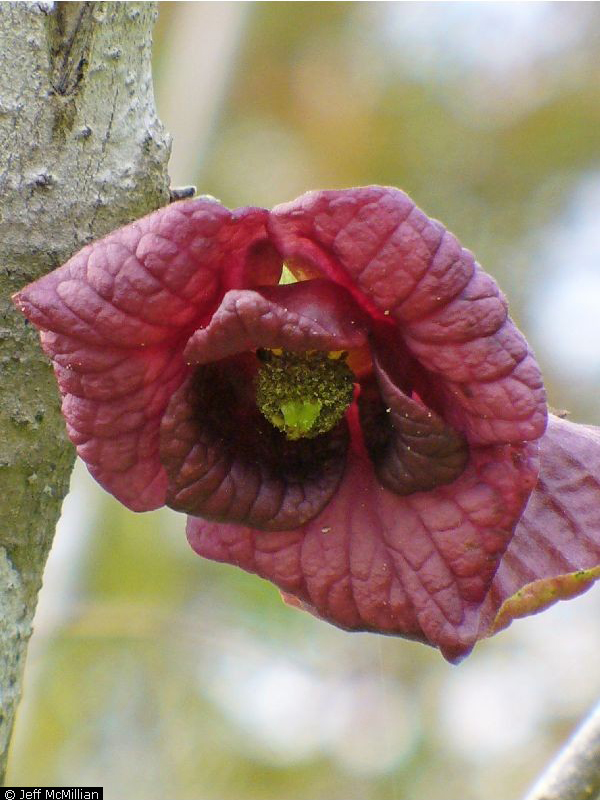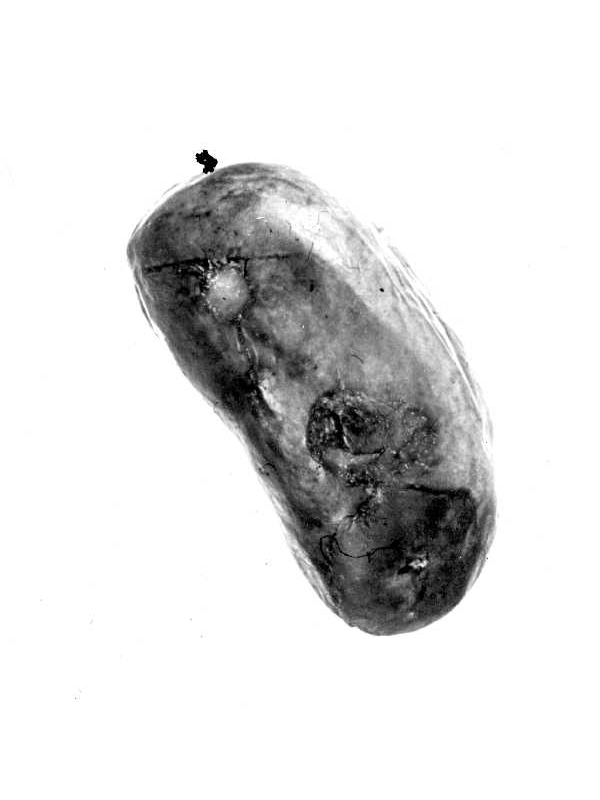Asimina triloba
Latin name: Asimina triloba
Common name: Pawpaw, Common Pawpaw, Custard Apple, Indian Banana, Wild Banana 10
Flowers: Purple, 4 to 5cm, bloom April to May, inconspicuous 16
Fruit: Green, yellowish to brown, cylindrical, mango-shaped fruits, 7-16 cm long and grow solitarily or 2 to 4 together that ripen between August and October 16
Height & Width: 9 to 40 ft tall, 20 ft wide 16
Type: Deciduous 10
Habit: Pyramidal 20
Wetland indicator category**: FAC 16 SC regions include (2) Eastern Mountain Piedmont
Texture: Bark is smooth with wart-like lenticels 20 coarse 16
Growth rate: Slow 16, medium 20
Light: Sun, part-shade, shade 10
Moisture: Medium 16
Soil*: Prefers moist course, textured soil with pH 4.7 to 7.2 16
Zones: 5a, 5b, 6a, 6b, 7a, 7b, 8a, 8b, 9a, 9b 20
Origin: L48 (N), CAN (N) 10
Ecosystem benefits: Larvae of the lovely Zebra Swallowtail butterfly (Eurytides marcellus) feed exclusively on Pawpaw leaves 16. Larvae of Pawpaw Sphinx (Dolba hyloeus) moth also feed largely on the leaves of the Pawpaw 10.




Features: The appearance of this tree gives a tropical flavor to temperate gardens and provides edible landscaping. The leaves are aromatic, with a smell reminiscent of bell pepper, and turn golden yellow in the fall. The fruit, which is the largest edible fruit native to North America, is high in amino acids 16. First recorded by the DeSoto expedition in the lower Mississippi Valley in 1541 10. The Cherokee and many other tribes used the pawpaw fruit for food. The Iroquois used this mashed fruit to make small cakes that were dried and stored. The dried cakes were soaked in water and cooked to make a sauce or relish that was served with cornbread. An ecological benefit of the pawpaw is larvae of the lovely Zebra Swallowtail butterfly (Eurytides marcellus) feed exclusively on the leaves 16. Warning: The fruit, though edible, can cause gastrointestinal upset in some individuals. SEEDS ARE TOXIC and skin irritation can occur when handling leaves 10.
Siting: Suitable for Butterfly, Edible, Pollinator, and Rain Gardens 20. Pawpaw’s can serve as a shrub screen or can be grown as an ornamental or fruit tree as they can be cultivated as a perennial tree or as a shrub. This plant spreads quickly by suckers to form a “pawpaw patch.” Simply remove suckers as they form if a tree form is desired. However, two trees are suggested for cross-pollination for fruit trees 16.
Care: Plant so root flare is visible at soil surface 14. At planting, water the root ball daily with two gallons of water per inch of trunk diameter for two weeks, every other day for two months, and then weekly until established. Modify water recommendations to reflect site drainage and rainfall. Apply 3” of mulch over the planted area. Do not allow mulch to touch the trunk 14. Trees are easily grown from scarified/stratified seeds. Fall sow in a shady location 16.
Pests: No serious disease or insect problems 10. Plants are relatively pest resistant if cultural preferences are met. However, Larvae of the lovely Zebra Swallowtail butterfly (Eurytides marcellus) feed exclusively on Pawpaw leaves 16. The larvae of the Pawpaw sphinx (Dolba hyloeus) moth also feed largely on the leaves of the Pawpaw 10.
This plant does not appear on the following invasive plant lists on 2/11/23:
X USDA SC Invasive Plant Species
X SC Exotic Plant Pest Council
Author: W. Brian Kirby
Image source: USDA, NRCS. 2023. PLANTS Database 02/09/2023. National Plant Data Team, Greensboro, NC 27401-4901 USA. 16
Sources:
- Armitage, A. (2001). Armitage’s manual of annuals, biennials, and half-hardy perennials. Portland, OR: Timber Press.
- Armitage, A. (2006). Armitage’s native plants for North American gardens. Portland, Oregon: Timber Press.
- Armitage, A. (2008). Herbaceous perennial plants: A treatise on their identification, culture, and garden attributes. Athens, GA: University of Georgia.
- Clemson Cooperative Extension Home and Garden Information Center.(2011). Flowers fact sheets. Retrieved from http://www.clemson.edu/extension/hgic/plants/landscape/ flowers/
- Clemson Cooperative Extension Home and Garden Information Center.(2011). Groundcovers & vines fact sheets. Retrieved from http://www.clemson.edu/ extension/hgic/plants/landscape/groundcovers/
- Clemson Cooperative Extension Home and Garden Information Center.(2011). Trees. Retrieved from http://www.clemson.edu/extension/hgic/ plants/landscape/trees/
- Clemson Cooperative Extension Home and Garden Information Center.(2011). Shrubs. Retrieved from http://www.clemson.edu/extension/hgic/plants/landscape/shrubs/
- Dirr, M. A. (2009). Manual of woody landscape plants. Champaign, IL: Stipes Publishing.
- Gilman, E. F. (1997). Trees for urban and suburban landscapes. Albany, NY: Delmar Publishers.
- Lady Bird Johnson Wildflower Center University of Texas at Austin. (2012). Native plant information network. Retrieved from http://www.wildflower.org/explore/
- McMillan, P., Plant taxonomist Clemson University, personal communication.
- Missouri Botanical Garden Kemper Center for Home Gardening. Plant finder. Retrieved from http://www.mobot.org/gardeninghelp/plantfinder/Alpha.asp
- North Carolina State University (2005). Plant fact sheets. Retrieved from http://www.ces.ncsu.edu/depts/hort/consumer/factsheets/index.html
- Strother, E. V., Ham, D. L., Gilland, L. (2003) Urban tree species guide: Choosing the right tree for the right place. Columbia, SC: South Carolina Forestry Commission.
- University of Florida, IFAS Extension. (2011). Southern trees fact sheet. Retrieved from http://edis.ifas.ufl.edu/department_envhort-trees
- USDA . Plant profile. (n/d).Retrieved from http://plants.usda.gov/java/
- USDA. Plant wetland indicator status. (n/d). Retrieved from http://plants.usda.gov/wetland.html
- Vincent, E., Environmental horticulturist Clemson University, personal communication.
- Clemson Extension. Carolina Yards Plant Database. Retrieved from https://www.clemson.edu/extension/carolinayards/plant-database/index.htm
- NC State University, Extension Gardener, Plant Toolbox. Retrieved from https://plants.ces.ncsu.edu/plants/asimina-triloba/
*Soil pH is determined using a professional soil test. Contact your Clemson University County Extension service for assistance www.clemson.edu/extension/. Click on “local offices”.
**2012 Plant Wetland Indicator categories (quantitative derived) http://plants.usda.gov/wetinfo.html
| Indicator Code | Indicator Status | Comment |
|---|---|---|
| OBL | Obligate Wetland | Almost always is a hydrophyte, rarely in uplands |
| FACW | Facultative Wetland | Usually is a hydrophyte but occasionally found in uplands |
| FAC | Facultative | Commonly occurs as either a hydrophyte or non-hydrophyte |
| FACU | Facultative Upland | Occasionally is a hydrophyte but usually occurs in uplands |
| UPL | Obligate Upland | Rarely is a hydrophyte, almost always in uplands |
